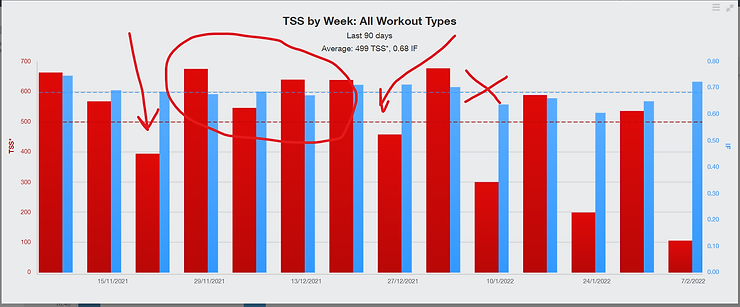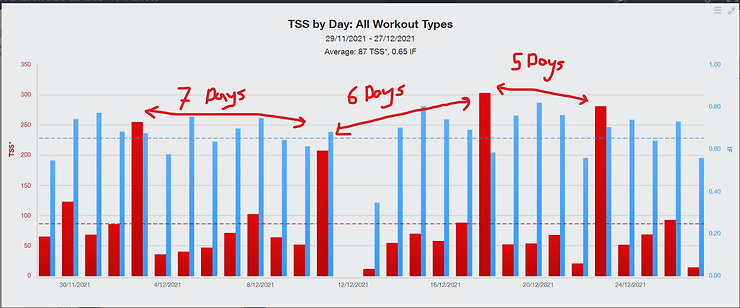This blog is as much for me, as it is for others, as I try to figure out how I went from running the fastest times in my life to having a stress fracture in my sacrum.
“Warden et al (2021) reported that bone stress injuries symptoms typically begin appearing approximately 3-4 weeks following a major workload ‘error’. Such errors may include insufficient recovery time between bone loading bouts (i.e., training sessions), sudden increases in weekly workload in terms of number of loading cycles (i.e., miles or kilometres run), and/or an increase in training intensity.” An excerpt taken from Brad Beer’s article “Sacral bone stress injuries in runners”
Brad outlines multiple biological and biomechanical risk factors that can be attributed to the development of bone stress injuries. I believe mine to be training load based, a common cause identified by Warden et al (2021).
The Big Change To My Training Load
Compared with my previous training, the design of my training plan over the 2021-2022 summer period had one major difference—an additional 4th week in one training block. Usually, I train in 2-3 week blocks, knowing from previous experience that anything more generally leaves me feeling run down and lethargic. However, over the Christmas period I figured that being on holiday, the stress of an extra week would be countered by that extra recovery gained from chilling at the beach. This would also allow my programme to work a lot better logistically in terms of family commitments and subsequent training weeks in the lead up to the Tarawera Ultra. I also wanted to push my limits to see if I was capable of handling more (spoiler alert, I’m not!)

Being a professional coach and lover of data, I know my numbers. I know a training stress score of 700 or more in a week is my upper limit. Within my 4-week training block, I hit TSS numbers of 675, 546, 638, 639, and a recovery week of 438. Based on those numbers, I knew I wasn’t doing anything crazy on a weekly basis. However, our biology doesn’t operate on a Monday – Sunday schedule!
Where I believe I made the significant mistake that subsequently led to my sacral stress fracture was not only adding an additional fourth week but also running a long run (65km) with minimal recovery (5 days) from my previous long run (65 km), the combination of which drastically reduced my ability to recover from training.

What about track running?
Those that regularly follow me will have seen that I was smashing my PBs on the track with two sub-9 min 3000 m races. While these efforts were hard, I personally don’t believe I overdid the intensity within my training plan. I only did one speed session per week, and the meat of the workout only included 6-8 min of fast running. I’d be ignorant to think the speed sessions didn’t add fatigue, but I’ve done more intensive 5-10km training sessions in ultramarathon build-ups without issue. Therefore, I believe it was the increased load and reduced time between loading that was the biggest contributor to my bone stress injury.
I had no idea until it was too late.
Not only was I feeling amazing during my training, but I was also running the fastest I ever had. I was on holiday and napping every day. I was eating well and had zero signs of excess fatigue or injury.
My pain came on all at once, and from there I tried to run through some excruciating pain thinking I was dealing with piriformis syndrome, before finally admitting to myself that I was broken—mainly because Brad Beer rang me after seeing an Instagram post and said you need to get an MRI. Thank you Brad!
The recovery process
At the time of writing, it’s been a couple of weeks since I last ran, and I’ll have at least another four weeks off. I don’t have any pain or discomfort while walking or chasing my son around the house. I’ve done a lot of mountain biking and road cycling, but since seeing a specialist, I’m going to chill out of that for a couple of weeks to let a lot of my tendons and ligaments chill as they’re inflamed from the trauma of me trying to run with a broken sacrum!
You can follow my return from injury on my Instagram and Facebook Pages

Dr Will O’Connor
Sports Scientist, Coach, Educator
My goal is to provide accessible, actionable, innovative and relevant content to runners and coaches so that they can achieve their desired outcomes.
I have a PhD in Sports Science and a graduate certificate in adult teaching. I work as a consultant helping individuals and businesses with sport and exercise science education.

